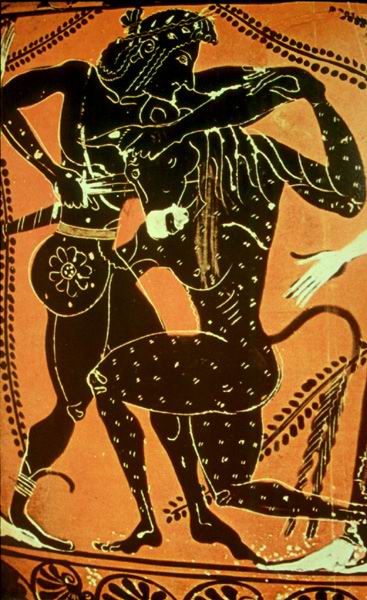
© Public domainThe Greek hero Theseus slays the minotaur in this 6th-century depiction on pottery.
The civilization made famous by the myth of the Minotaur was as warlike as their bull-headed mascot, new research suggests.
The ancient people of Crete, also known as Minoan, were once thought to be a bunch of peaceniks. That view has become more complex in recent years, but now University of Sheffield archaeologist Barry Molloy says that war wasn't just a part of Minoan society - it was a defining part.
"
Ideologies of war are shown to have permeated religion, art, industry, politics and trade, and the social practices surrounding martial traditions were demonstrably a structural part of how this society evolved and how they saw themselves," Molloy said in a statement.
The ancient MinoansCrete is the largest Greek isle and the site of thousands of years of civilization, including the Minoans, who dominated during the Bronze Age, between about 2700 B.C. and 1420 B.C. They may have met their downfall with a powerful explosion of the
Thera volcano, which based on geological evidence seems to have occurred around this time.
The Minoans are perhaps most famous for the myth of the Minotaur, a half-man, half-bull that lived in the center of a labyrinth on the island.
Minoan artifacts were first excavated more than a century ago, Molloy said, and archaeologists painted a picture of a peaceful civilization where war played little to no role. Molloy doubted these tales; Crete was home to a complex society that traded with major powers such as Egypt, he said. It seemed unlikely they could reach such heights entirely cooperatively, he added.
"As I looked for evidence for violence, warriors or war, it quickly became obvious that it could be found in a surprisingly wide range of places," Molloy said.
War or peace?For example, weapons such as daggers and swords show up in Minoan sanctuaries, graves and residences, Molloy reported in November in
The Annal of the British School at Athens. Combat sports were popular for men, including boxing, hunting, archery and bull-leaping, which is exactly what it sounds like.
Hunting scenes often featured shields and helmets, Molloy found, garb more suited to a warrior's identity than to a hunter's. Preserved seals and stone vessels show daggers, spears and swordsmen. Images of double-headed axes and boar's tusk
helmets are also common in Cretian art, Molloy reported.
Even the yet-undeciphered language of Minoan may hint at a violent undercurrent. The hieroglyphs include bows, arrows, spears and daggers, Molloy wrote. As the script is untranslated, these hieroglyphs may not represent literal spears, daggers and weapons, he said, but their existence reveals that weaponry was key to Minoan civilization.
"There were few spheres of interaction in Crete that did not have a martial component," Molloy said.
Some of the violent nature of Minoan society might have been missed because archaeologists find few fortified walls on the island, Molloy wrote. It may be that the island's rugged topography provided its own defense, he said, leaving little archaeological evidence of battles behind.
their unused axes.
They were the commerce of the Med. Initially the non warlike assumption was made due to the fact that Knossos was virtually undefended by walls, no soldiers barracks, etc.
I suspect they were the first in manipulation of the media. No fierce war friezes, and no war ships. How did they do this? I suspect they hired out their violent aspect to mercenaries like the Phoenicians so they themselves could be just 'merchants,' and as Evans , the excavator of Knossos, wrote, they were exacting in their grain records; the harvest was apportioned with the major share going to 'the lady" which directs any anger to a diety that wasn't even represented in any way except words. That they were strict managers is indicated by the records Evans deciphered: wheat to men, lesser amounts of barley to slaves, and even lesser amounts to women. So much for the high status of women; it was merely another successful media ploy to hide behind.